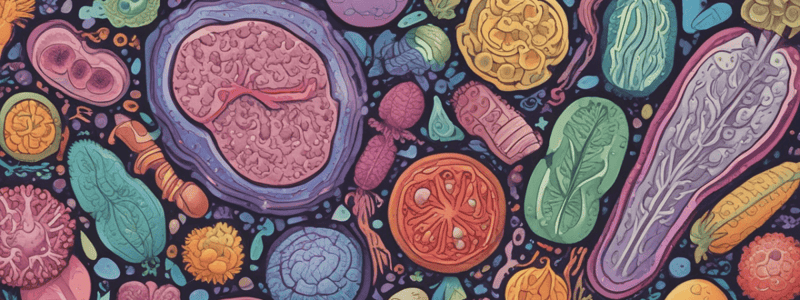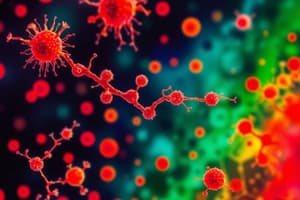Podcast
Questions and Answers
What are the key abilities of microorganisms that contribute to disease development?
What are the key abilities of microorganisms that contribute to disease development?
multiply, attach to target sites, evade the immune system, and obtain nutrients from the host
Provide two examples of fungal diseases.
Provide two examples of fungal diseases.
Yeast infections and Valley fever
What is a common symptom of viral infections?
What is a common symptom of viral infections?
Runny nose, muscle aches, and upset stomach
What is an important control measure for preventing bacterial infections?
What is an important control measure for preventing bacterial infections?
What is a characteristic symptom of fungal infections?
What is a characteristic symptom of fungal infections?
What is a control measure for preventing viral infections?
What is a control measure for preventing viral infections?
Provide two examples of bacterial diseases.
Provide two examples of bacterial diseases.
What is a common symptom of bacterial infections?
What is a common symptom of bacterial infections?
What is the approximate age of the first forms of life that developed on Earth?
What is the approximate age of the first forms of life that developed on Earth?
When did most life forms on Earth remain as microorganisms?
When did most life forms on Earth remain as microorganisms?
What is the term used to describe the study of viruses?
What is the term used to describe the study of viruses?
What is the process that allows microorganisms to exchange genes between divergent species?
What is the process that allows microorganisms to exchange genes between divergent species?
What is the result of rapid evolution in microorganisms, which is significant in medication?
What is the result of rapid evolution in microorganisms, which is significant in medication?
What are the dual roles of microorganisms in diseases?
What are the dual roles of microorganisms in diseases?
What is the age of the amber in which microbes, algae, and fungi have been recognized?
What is the age of the amber in which microbes, algae, and fungi have been recognized?
What is the term used to describe the microorganisms that produce methane?
What is the term used to describe the microorganisms that produce methane?
What are the six major types of microorganisms?
What are the six major types of microorganisms?
What are the three domains of life that microorganisms are found in?
What are the three domains of life that microorganisms are found in?
What is food microbiology and what does it study?
What is food microbiology and what does it study?
What is the role of microorganisms in maintaining the Earth's environment?
What is the role of microorganisms in maintaining the Earth's environment?
Explain how microorganisms can be both beneficial and harmful.
Explain how microorganisms can be both beneficial and harmful.
What are the key learning objectives of ERF 215: Principles of Food Microbiology?
What are the key learning objectives of ERF 215: Principles of Food Microbiology?
Why is the study of microorganisms important in the context of food?
Why is the study of microorganisms important in the context of food?
How does the diversity of microorganisms impact food microbiology?
How does the diversity of microorganisms impact food microbiology?
How do bacteria differ from viruses in terms of their reproduction?
How do bacteria differ from viruses in terms of their reproduction?
What is the role of microbes in nutrient cycling?
What is the role of microbes in nutrient cycling?
Why are fungal infections particularly dangerous for immunocompromised individuals?
Why are fungal infections particularly dangerous for immunocompromised individuals?
List a mechanism by which bacteria can cause disease?
List a mechanism by which bacteria can cause disease?
What distinguishes viruses from bacteria in terms of cellular structure?
What distinguishes viruses from bacteria in terms of cellular structure?
Identify a disease caused by bacteria and explain its impact.
Identify a disease caused by bacteria and explain its impact.
What type of organism are fungi classified as, and how do they affect the ecosystem?
What type of organism are fungi classified as, and how do they affect the ecosystem?
How do viruses spread throughout the body once they hijack host cells?
How do viruses spread throughout the body once they hijack host cells?
How do microbes contribute to soil formation and fertility?
How do microbes contribute to soil formation and fertility?
What is the significance of nitrogen fixation in symbiotic relationships involving microbes?
What is the significance of nitrogen fixation in symbiotic relationships involving microbes?
In what ways do microbes play a role in bioremediation?
In what ways do microbes play a role in bioremediation?
Describe the fermentation process and its significance in the food industry.
Describe the fermentation process and its significance in the food industry.
How do microbes enhance the safety of high-risk foods?
How do microbes enhance the safety of high-risk foods?
What role do antimicrobial compounds produced by microbes play in food preservation?
What role do antimicrobial compounds produced by microbes play in food preservation?
Explain how microbial activities contribute to the resilience of ecosystems.
Explain how microbial activities contribute to the resilience of ecosystems.
What are the benefits of using microbes in improving food quality?
What are the benefits of using microbes in improving food quality?
Flashcards are hidden until you start studying
Study Notes
Introduction to Food Microbiology
- Food microbiology is the study of microorganisms in food, their effects on food quality, safety, and health.
- Microbiology is the study of microbes, a diverse group of generally minute life-forms that include bacteria, archaea, algae, fungi, protozoa, and viruses.
Development of Microorganisms as a Science
- Microorganisms make up a huge part of the planet's living material and play a significant role in maintaining the Earth's environment.
- Microorganisms are ubiquitous in nature and are valuable to life, but some can cause serious harm.
- They can be classified into six significant types: bacteria, archaea, fungi, protozoa, algae, and viruses.
Structures of Microorganisms
- Prokaryotes (bacteria and archaea) are microscopic, while some eukaryotes (protozoa, fungi, and algae) are also microscopic.
- Viruses are not living and are not considered microorganisms, but are studied in virology.
Evolution of Microorganisms
- Single-celled microorganisms were the first forms of life to develop on Earth, around 3.5 billion years ago.
- Microorganisms have a moderately quick pace of evolution due to their rapid replication, horizontal gene transfer, and high mutation rate.
- This rapid evolution has led to the development of multidrug-resistant pathogenic bacteria (superbugs).
Roles of Microorganisms in Diseases
- Microorganisms play a dual role in diseases: beneficial (aiding in digestion and immune defense) and harmful (causing infections).
- Bacteria, viruses, protozoa, fungi, and worms can disrupt cellular activities, leading to diseases when they invade host cells.
- Examples of diseases caused by microorganisms:
- Bacterial diseases: strep throat, tuberculosis, tetanus, Lyme disease, pneumonia, gonorrhea, gastric ulcers
- Fungal diseases: yeast infections, valley fever, meningitis, athlete's foot, ringworm
- Viral diseases: common cold, influenza, HIV/AIDS, hepatitis, Ebola hemorrhagic fever, herpes simplex, rhinovirus infections, coronavirus infections
Control Measures for Infectious Diseases
- Bacterial infections: proper hygiene practices, use of antibiotics, disinfection of areas with high bacterial concentrations
- Fungal infections: keeping perishable food at the correct temperature, avoiding sharing personal items
- Viral infections: regular handwashing, receiving recommended vaccinations, avoiding close contact with infected individuals, disinfecting surfaces in high-traffic areas
Role of Microorganisms in the Environment
- Nutrient cycling and decomposition: microorganisms break down complex organic matter and recycle nutrients like carbon, nitrogen, and phosphorus
- Symbiotic relationships: microorganisms form mutualistic symbioses with other organisms, providing benefits like nitrogen fixation for plants
- Bioremediation and environmental sustainability: microorganisms can degrade or transform various pollutants, contributing to the maintenance of natural ecosystems
Role of Microorganisms in Food Industry
- Fermentation: microorganisms are used to ferment foods like dairy products, bread, vinegar, wine, and beer
- Food preservation: microorganisms are used to preserve food by inhibiting the growth of spoilage microorganisms
- Food quality improvement: microorganisms can enhance the quality of food by improving its flavor, aroma, texture, and digestibility
- Food safety: microorganisms are used to ensure food safety by controlling the growth of pathogens and spoilage microorganisms
Studying That Suits You
Use AI to generate personalized quizzes and flashcards to suit your learning preferences.




